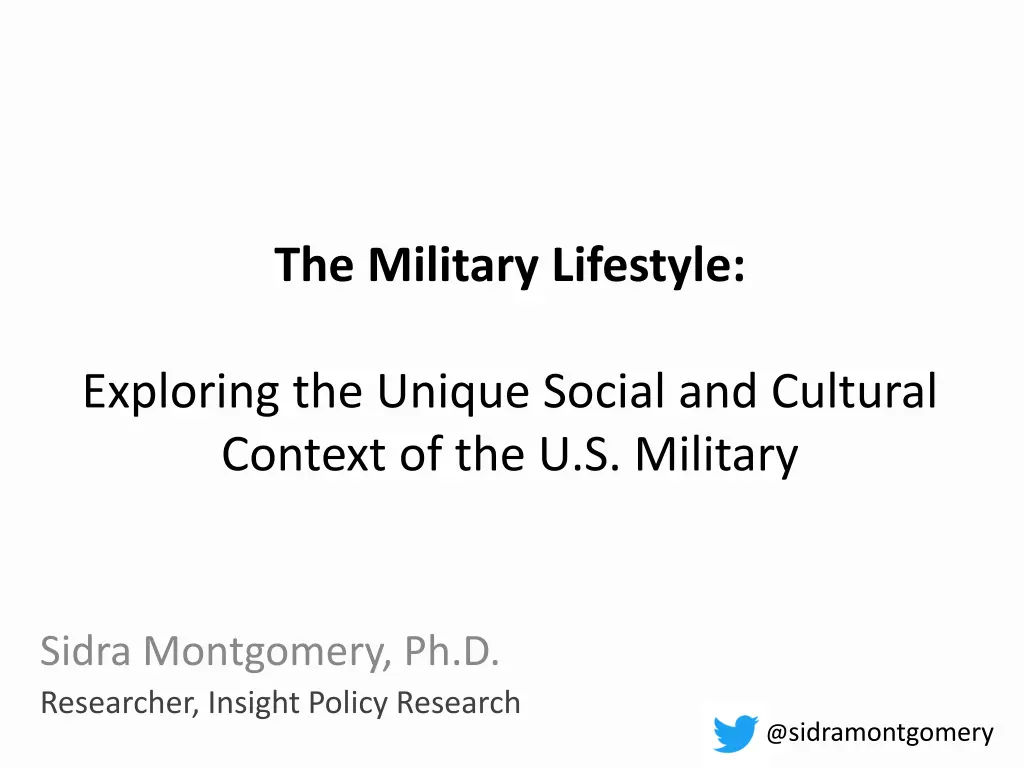
Exploring the Unique Social and Cultural Context of the U.S. Military Lifestyle
Dive into the sociological aspects of the military lifestyle, including demographic makeup, challenges for service members and families, and the intersection of life and service. Learn about the characteristics of those who serve in the U.S. military and the impact of historical time and place on their lives.
Download Presentation

Please find below an Image/Link to download the presentation.
The content on the website is provided AS IS for your information and personal use only. It may not be sold, licensed, or shared on other websites without obtaining consent from the author. If you encounter any issues during the download, it is possible that the publisher has removed the file from their server.
You are allowed to download the files provided on this website for personal or commercial use, subject to the condition that they are used lawfully. All files are the property of their respective owners.
The content on the website is provided AS IS for your information and personal use only. It may not be sold, licensed, or shared on other websites without obtaining consent from the author.
E N D
Presentation Transcript
The Military Lifestyle: Exploring the Unique Social and Cultural Context of the U.S. Military Sidra Montgomery, Ph.D. Researcher, Insight Policy Research @sidramontgomery
Sociological Imagination Private Troubles Public issues
Demographic make-up of the military Military service and the lifecourse What makes the military institution unique? Common challenges for servicemembers, spouses, and families
Who Serves in the U.S. Military? Demographic characteristics of the 21st century force
Who Serves in the U.S. Military? Active-Duty (2017): Rank: 82% Enlisted; 17% Officers Age: 45% 25 or younger, 21% 26 to 30 years old, 33.8% 31 or older Race and Ethnicity: 68% White, 17% Black/African-American, 4.5% Asian; 15% Hispanic/Latino Ethnicity Gender: 83% Male, 16% Female
Who Serves in the U.S. Military? Active-Duty (2017): Marital Status: 52% married, 42% never married, 5% divorced Children: 38% have children Geographic Region: primarily from the South Family Service: 80% have family service, 25% have parents who served Socioeconomic Background: Lower to middle class
Military Service and the Life Course Intersection of life and service
Military Service and the Lifecourse Lifecourse Perspective: how does historical time and place shape lives? All-Volunteer Force Post-9/11 generation Iraq and Afghanistan wars Widest gap between military service and civilian lives
Military Service and the Lifecourse Lifecourse Perspective: the meaning, impact, and timing of life transitions Transition to Adulthood: Financial independence Identity shifts Intimate partnerships and family formation Education and professional experience Physical and psychological health
What Makes the Military Institution Unique? Not your normal profession/occupation
Military as a greedy institution Greedy institutions seek exclusive and undivided loyalty and they attempt to reduce the claims of competing roles and status positions on those they wish to encompass within their boundaries. Their demands on the person are omnivorous (Coser 1974: 6)
The military is unique in the constellation of requirements and pattern of demands it makes of it s servicemembers and their families (M. Segal 1986: 15) 1. Risk of Injury or Death 2. Geographic Mobility 3. Separations 4. Residence in Foreign Countries 5. Normative Constraints
Social and Cultural Norms in the U.S. Military Substantial socialization process Hierarchy (structural and social) Customs, traditions, and legacies Explicit Values (honor, loyalty, respect, integrity) Discipline and mental/physical toughness Masculine-dominated Warrior symbol and warrior ethos Sub-cultures based on Service branch, occupational specialty, etc.
Military instiution Greedy nature of the military extends beyond servicemembers, it also impacts families Servicemembers Spouses, Children, Family Members
Common Challenges Among Military Families Impacts of the military lifestyle
Military Spouse Employment Financial Wellness Mental Health Community Connection
Military Spouse Employment Factors: Frequent geographic mobility, deployments, and local military installation labor markets 16-24% of military spouses are unemployed Underemployment can be an even larger issue Military spouses are losing income, retirement benefits, and may lack career progression or advancement
Military Family Financial Wellness Factors: Frequent geographic mobility, spouse employment issues, early family formation 60% of families do not have enough savings to cover three months of living expenses (MFAN 2017) 15% of military families report issues of food insecurity (Wax and Stankorb 2016) PCS moves can cause additional financial stress
Military Family Mental Health Factors: Lifestyle stress and strain, family separation, military culture Stigma of mental health problems in military, supposed to be resilient spouses who do it all Depression, anxiety, and mental health challenges for military spouses Moving and deployments can be challenging for children s mental health and wellness
Military Families and Community Factors: Frequent geographic mobility, disconnect with civilians, military culture and norms Geographically distant from family and friends Lack of connection and investment in local civilian community Isolation, even within military community
In Summary Use sociological imagination to better understand the structure and social context of U.S. military How institutional demands shape the lives of servicemembers and their families Identify some of the common challenges within the military community
Thank You! Sidra Montgomery, Ph.D. sidra.montgomery@gmail.com @sidramontgomery
